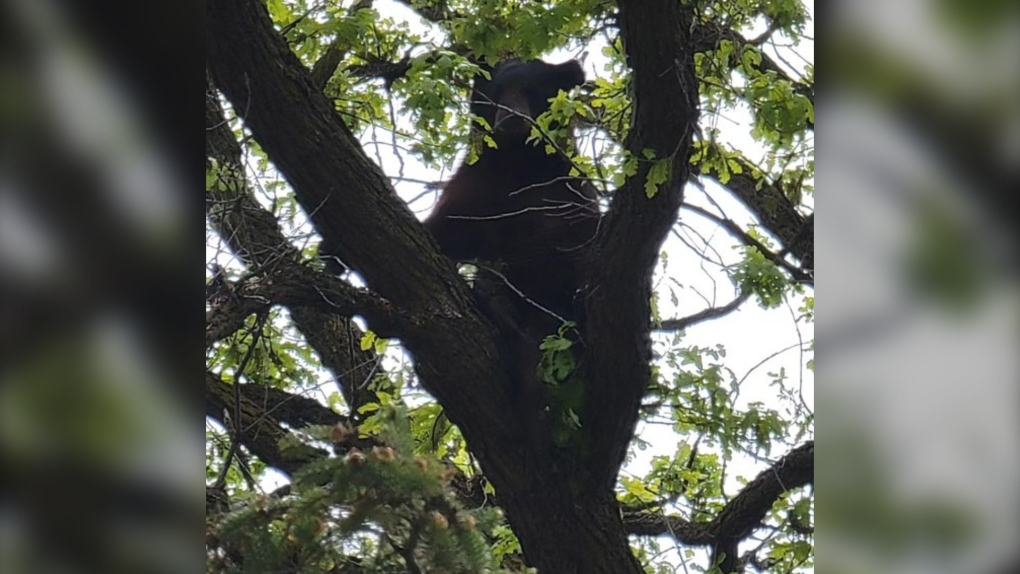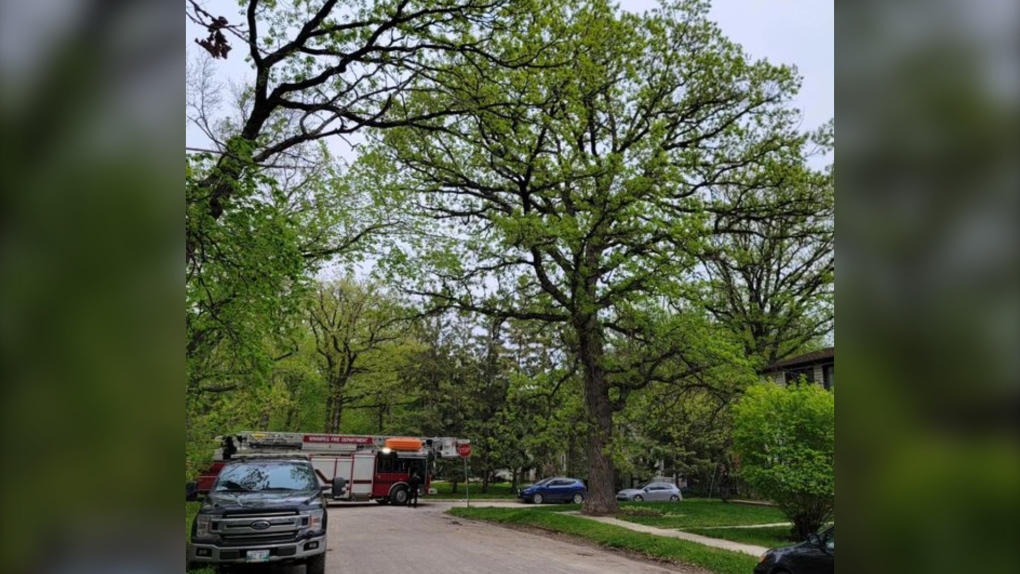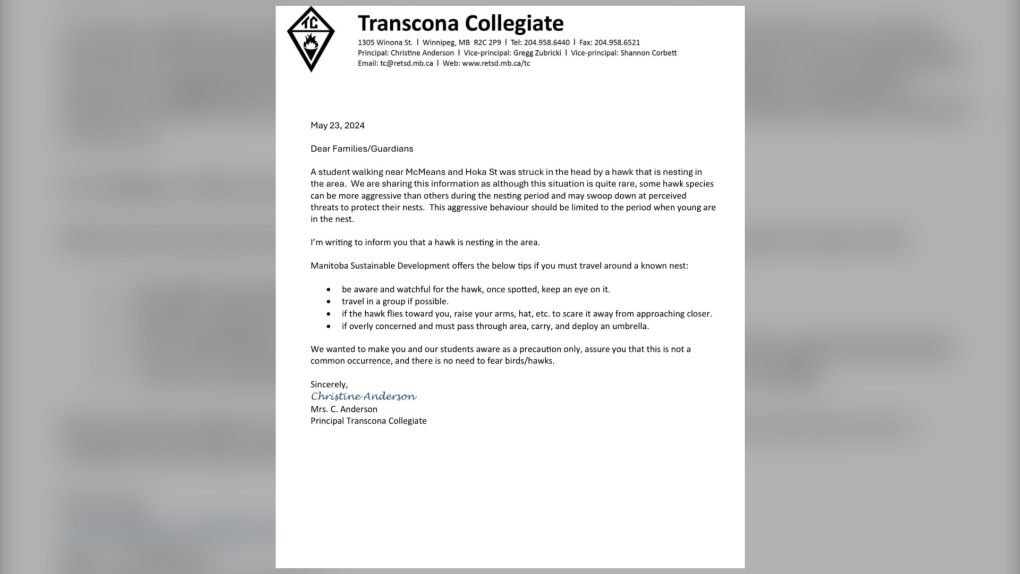‘It’s pretty alarming’: Urban wildlife encounters in Winnipeg this week
When you consider what kind of animals you might encounter in your Winnipeg neighborhood, a bear probably isn’t on your list.
But that’s exactly what residents of Wildwood stumbled upon on Tuesday.
A black bear was spotted roaming around the residential area.
“Living in Wildwood, it’s very normal to come across different types of animals and creatures within the neighbourhood," said area resident Nicholas Gray. "I was working from home and saw on Facebook that there was an alert of a black bear, which I thought was very surprising."
 A black bear up in a tree in Winnipeg's Wildwood neighbourhood on May 21, 2024 (Nicholas Gray)
A black bear up in a tree in Winnipeg's Wildwood neighbourhood on May 21, 2024 (Nicholas Gray)
“I've seen everything and anything that you could think of in the neighborhood,” he said, adding the bear eventually ended up in a very tall tree.
He said the bear’s choice to curl up at the top of a tree put a wrench in Manitoba Conservation’s plan to sedate it.
"The fire crew was there (and) they were talking about trying to get it into the bucket," Gray noted. "Because there were too many people around the base of the tree, the bear kept crawling up higher."
 WFPS responded to a bear in a tree in Wildwood on May 21, 2024 (Nicholas Gray)
WFPS responded to a bear in a tree in Wildwood on May 21, 2024 (Nicholas Gray)
"They didn't want to tranquillize it too high up for it to fall down, injure itself," he said. "It became basically a waiting game for nightfall for people to kind of go back home."
The hope was that the bear would eventually feel safe and come down on its own after the crowd had dispersed, Gray explained. But it was quite a surprise for him to see the wild creature on a city street, lingering so close to home.
“It's pretty alarming. I've got two dogs," he said, "It's a very open neighbourhood so my dogs are always off leash."
Gray said the dogs mostly ignore wildlife, like deer, but a bear would be a different story.
"I don't know what they would do if there was a bear wandering through my yard."
Hawk Attacks
The bear isn’t the only unusual display of wildlife in the city recently.
On Wednesday and Thursday, there were multiple reports of aggressive hawk attacks in Transcona’s McMeans Bay area.
It's not the first time the Transcona terror has struck.
Facebook users wrote of children attacked and warned others not to walk in the area without having their eyes on the skies.
Meanwhile, Transcona Collegiate issued a letter to families about one of its students experiencing an unpleasant hawk encounter.
“A student walking near McMeans and Hoka St. was struck in the head by a hawk that is nesting in the area,” wrote school principal Christine Anderson.
 A letter from Transcona Collegiate warning families about a hawk attack
A letter from Transcona Collegiate warning families about a hawk attack
She explained a potential reason for the hawk’s aggressive demeanour.
“We are sharing this information as although this situation is quite rare, some hawk species can be more aggressive than others during the nesting period and may swoop down at perceived threats to protect their nests. This aggressive behaviour should be limited to the period when young are in the nest. I’m writing to inform you that a hawk is nesting in the area,” said Anderson.
CTV contacted the province for comment, confirming hawk activity in Winnipeg.
“Manitoba Conservation has received three reports of incidents involving hawks and staff are in the process of installing signage to advise people to use caution in the area,” said a provincial spokesperson.
As for why the hawks haven’t been removed the spokesperson explained, “Legislation prevents the removal of the hawk, nestlings, and nest.”
If you find yourself in an area adjacent to a nest, the province noted there are a variety of ways to stay safe.
The simplest solution it says “is to give the nest a wide berth.”
It also suggests keeping a watchful eye on it hawks and travelling in a group if possible.
If a hawk flies towards you it recommends raising your arms, hats, etc. to scare it away from approaching closer.
And, if you must pass through the area, the province suggests wearing a hat and sunglasses, carrying and deploying an umbrella, and avoiding running or biking around the nest.
CTVNews.ca Top Stories

Thousands of structures destroyed in L.A. County's most destructive fire
A series of wildfires tore through densely populated parts of the Los Angeles, Calif. area. Five people have been reported dead. U.S. Gov. Gavin Newsom said thousands of resources have been deployed to contain the fires.
Is the Hollywood sign on fire?
As fires scorch Los Angeles, fake images and videos of a burning Hollywood sign have circulated on social media.
U.S. Supreme Court rejects Trump's bid to delay sentencing in his New York hush money case
A sharply divided U.S. Supreme Court on Thursday rejected president-elect Donald Trump's final bid to put his New York hush-money case on hold, clearing the way for him to be sentenced for felony crimes days before he returns to the presidency.
Ex-Trump adviser says Canada in 'difficult position' amid tariff threat, Trudeau resignation
In the face of a potential tariff war, U.S. president-elect Donald Trump's former national security adviser John Bolton says 'Canada is in a difficult position' in part due to Prime Minister Justin Trudeau's resignation and a looming general election.
PM Trudeau says he thinks Trump is using talk of Canada becoming 51st state to distract from tariff impact
Prime Minister Justin Trudeau says he thinks U.S. president-elect Donald Trump is drumming up drama on Canadian statehood to detract from tariff talks.
Canadian travellers now require an ETA to enter U.K. Here's what to know
Starting Jan. 8, Canadians visiting the U.K. for short trips will need to secure an Electronic Travel Authorization (ETA) before boarding their flight, according to regulations set out by the U.K. government.
'True when I said it, true today': former Canadian PM Harper pushes back against Trump on social media
Former prime minister Stephen Harper doesn’t find U.S. president-elect Donald Trump’s jibes about Canada becoming the 51st U.S. state very amusing.
Poilievre says the next Canadian election will be about the carbon price
Pierre Poilievre returned to Ottawa on Thursday after the holidays with a familiar demand for Justin Trudeau: call a carbon-tax election.
More than 150 students sick at University of Guelph, says public health
More than 150 cases of gastroenteritis have been reported at the University of Guelph.
































